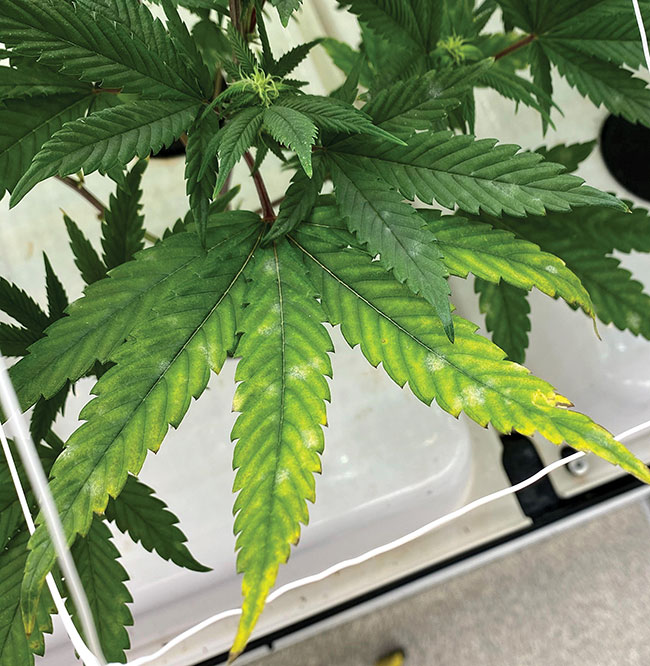
Features
Cultivation
Production
Get growing down to a science
Knowledge of plant mechanics key to successful crop
January 8, 2021 By Mohyuddin Mirza
 These plants have been grown on a VPD of between 7 and 13 millibars. Powdery mildew is a major issue associated with high VPD, while magnesium deficiency is evident due to nutrient management issues.
These plants have been grown on a VPD of between 7 and 13 millibars. Powdery mildew is a major issue associated with high VPD, while magnesium deficiency is evident due to nutrient management issues. When I see the news in the media that some cannabis facilities have not been successful in growing cannabis and did not get their sale licences because the quality standards were not met, I get really worried.
Enough body of scientific knowledge is available but why are we not able to apply that knowledge? There is a disconnect somewhere.
Take the example of a hydroponics cannabis grower who somehow decided to use agricultural gypsum in his fertilizer program and failed many times to produce a crop. Why? Because gypsum is a calcium sulfate and is insoluble in water. It is used mostly as a soil amendment for growing outdoor crops. Gypsum is a slow reacting chemical and will take time to release calcium and sulfur. Cannabis needs highly soluble fertilizers and there are enough of them available for use in cannabis production. I could not get an answer as to why gypsum was used.
Most growers have very good and sophisticated HVAC systems for indoor and greenhouse facilities. They have a good set up to grow plants but then I see that their crops are being rejected due to high mould/microbial contents as well as poor-quality buds. When I see this, four questions generally come to mind:
- What is the air temperature, set points and actual?
- What is the relative humidity they are trying to maintain?
- What is the leaf temperature?
- What is the VPD?
VPD is vapour pressure deficit. Many growers don’t pay attention to this calculated value. From the cannabis viewpoint, this is the most important factor to determine if the plant is working. The plant’s function is to absorb water through the roots, transport it through the water conducting tissues or strands and move it to the leaves. From the leaves, the water is lost to the surrounding air and minerals are retained in the cells and used as building blocks. So imagine what that plant is doing, absorbing water in liquid form and transpiring it in a vapour form.
VPD thus describes the deficit of moisture between the inside of the leaves and in the air around the leaves. The higher the deficit, the higher will be the amount of water lost to the air. So if cannabis plants are subjected to higher VPD levels constantly, then the plant is under continuous stress. It will tell you this by very dark green color of leaves, smaller leaves which fail to expand, poor buds and root decay. One example will suffice.
Recently, I looked at the VPD data from an indoor facility. The air temperature was 23°C during the lighted period and elative humidity (RH) was 43 per cent. When I calculated the VPD, it was 1,917 kPa and 11.721 grams/m3 of air. When the leaf temperature was measured at 26°C and 43 per cent RH, the VPD was 1.917 kPa and VPD was 13.885 grams/m3 of air.
These settings have been going on for the past 20 days and plants are at bud stage. What it means is that the plant is heavily transpiring water to keep itself cool and stomata will close after a few hours of such a high VPD.
So the consequences are:
- Stomata are closed and plant cannot absorb carbon dioxide;
- It cannot carry on photosynthesis;
- Nutrients are accumulating in cells;
- Photo respiration is continued;
- Whatever food plant has made is being used for keeping cool, not to make new cells, new growth, buds and other organs;
- Ultimately, roots will start decaying;
- Powdery mildew will be rampant not only on the leaves but on buds as well and I have seen it on stems.
How could you expect a good quality crop with this kind of VPD, especially if this has been happening almost since the duration of the crop?
I will share with you how to use VPD readings to our advantage and for the advantage of the cannabis plant. The recommended range is between 3 and 7 grams/m3 of air. In this range the plant is working properly. If the light is optimum, and nutrients and water management is proper, then calculate how many hours of the lighted period the plants were in that window of 3-7 grams. Most computers show this value every few minutes and you can calculate the value.
This information will provide very useful information as to the workings of the plant. If plants are consistently in the “working” range then expect good quality buds. It can almost be predicted.
Mohyuddin Mirza, PhD, is chief scientist with the Cannabis Nature Company in Edmonton, and a consultant with the cannabis industry. Email him at drmirza@cannabisnature.ca.
Print this page